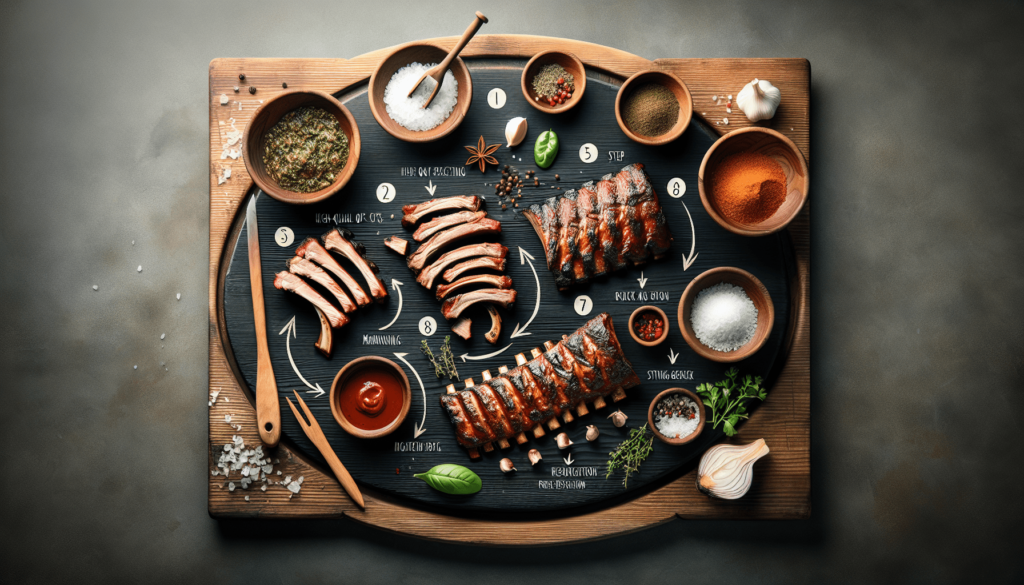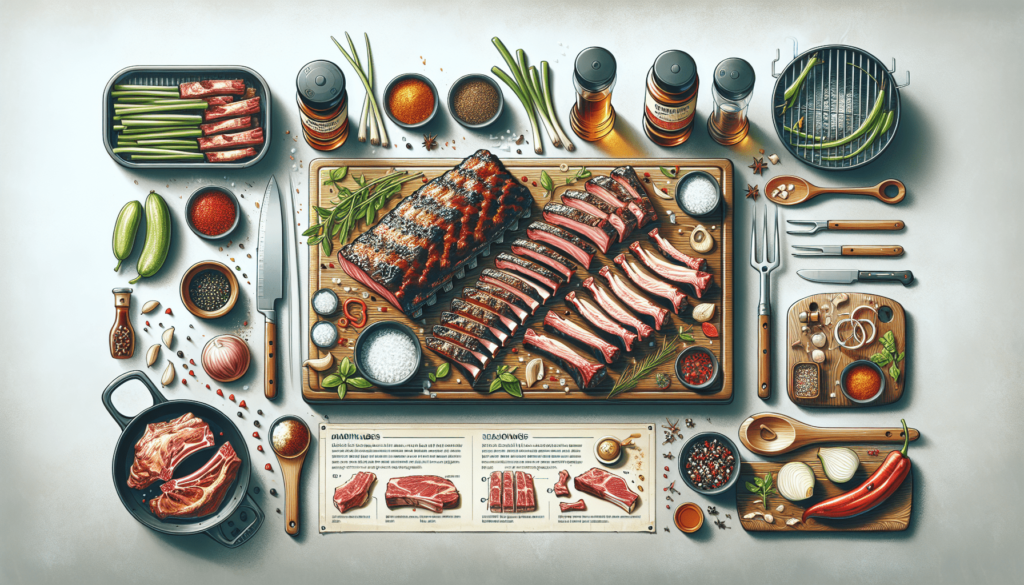Imagine a summer evening, the warm sun slowly setting as you gather around the grill with family and friends. The tantalizing aroma of perfectly grilled ribs fills the air, making your mouth water in anticipation. In this article, we will explore the art of grilling ribs, sharing valuable tips and techniques to ensure your ribs are tender, flavorful, and a hit at any backyard gathering. From selecting the right cut of meat to mastering the perfect seasoning, get ready to elevate your grilling game and become a rib connoisseur.
Choosing the Right Ribs
When it comes to grilling ribs, the first step is choosing the right type of ribs. There are three popular cuts of ribs that you can choose from: baby back ribs, spare ribs, and St. Louis style ribs. Each of these cuts has its own unique characteristics and flavor profile, so it ultimately comes down to personal preference.
Baby Back Ribs
Baby back ribs, also known as back ribs or loin ribs, are cut from the top of the rib cage between the spine and the spare ribs. They are called “baby” back ribs because they are shorter and smaller than spare ribs. Baby back ribs are known for their tenderness and relatively lean meat. They have a nice balance of meat and fat, which results in a juicy and flavorful end product.
Spare Ribs
Spare ribs come from the lower portion of the rib cage, closer to the belly, and have more connective tissue and fat compared to baby back ribs. They are larger, flatter, and have more meat than baby back ribs. Spare ribs have a rich and robust flavor, with plenty of marbling that adds to their juiciness. They require a longer cooking time to break down the tough connective tissue and become tender.
St. Louis Style Ribs
St. Louis style ribs are essentially spare ribs with the brisket bone removed and the rack trimmed into a more rectangular shape. This cut of ribs is known for its meatier and more even thickness compared to spare ribs. The removal of the brisket bone allows for more consistent cooking and easier handling. St. Louis style ribs are beloved for their meaty texture and rich flavor.
Preparing the Ribs
Before you start seasoning and grilling your ribs, it’s important to properly prepare them to ensure optimal taste and texture. There are two essential steps in preparing the ribs: removing the membrane and trimming excess fat.
Removing the Membrane
The membrane, also known as the silver skin, is a thin layer of connective tissue that lines the underside of the rack of ribs. While it is safe to eat, it can be tough and chewy when cooked, so it is generally best to remove it. To remove the membrane, gently lift one corner using a butter knife or your fingers, then grab it with a paper towel and pull it off in one swift motion. Removing the membrane allows for better absorption of the seasoning and smoke, resulting in more tender and flavorful ribs.
Trimming Excess Fat
While some fat is desirable for flavor and moisture, excessive fat can lead to an overly greasy end product. Trim any large pieces of fat from the surface of the ribs, being careful not to remove too much as it helps keep the meat moist during the cooking process. A general guideline is to leave about 1/4 inch of fat on the ribs.
Dry Rub or Marinade
Once the ribs are prepped and ready, it’s time to choose between using a dry rub or a wet marinade to season them. Both methods have their own merits, and it ultimately depends on your personal flavor preferences.
Dry rubs are a mixture of herbs, spices, and sometimes sugar that are applied directly to the surface of the ribs. They create a flavorful crust during the cooking process and add depth to the overall taste of the ribs. Popular dry rub ingredients include paprika, brown sugar, chili powder, garlic powder, and cayenne pepper. Experiment with different combinations to find your favorite flavor profile.
On the other hand, wet marinades are typically a combination of liquid ingredients such as vinegar, soy sauce, Worcestershire sauce, and various spices. Marinades are great for adding moisture and flavor to the ribs. You can either marinate the ribs overnight in the refrigerator or apply the marinade just before grilling.

Seasoning the Ribs
Once you have decided whether to use a dry rub or marinade, it’s time to season the ribs. The goal is to impart as much flavor as possible to the meat, whether you are using a dry rub or a wet marinade.
Dry Rubs
If you are using a dry rub, thoroughly coat the ribs with the mixture, making sure to cover all sides. Gently rub the mixture into the meat to ensure it adheres properly. Let the seasoned ribs sit for at least 30 minutes to allow the flavors to penetrate the meat.
Wet Marinades
If you opted for a wet marinade, thoroughly coat the ribs with the marinade, making sure to cover all sides. You can use a brush or your hands to evenly distribute the marinade. After applying the marinade, let the ribs sit in a covered container in the refrigerator for at least two hours, or overnight for maximum flavor absorption.
Flavor Combinations
When it comes to seasoning ribs, the flavor combinations are practically endless. Whether you prefer sweet and tangy or spicy and smoky, there are countless options to explore. Some classic flavor combinations include honey and mustard, brown sugar and chili powder, soy sauce and ginger, or maple and bourbon. Don’t be afraid to get creative and try different combinations to find your signature seasoning.
Preheating the Grill
Before you start grilling your ribs, it’s important to properly preheat your grill to ensure even cooking and beautiful grill marks. The preheating process varies depending on whether you are using a charcoal grill or a gas grill.
Using a Charcoal Grill
If you are using a charcoal grill, start by evenly distributing a layer of charcoal across the bottom grate. Light the charcoal using either a charcoal chimney starter or lighter fluid. Wait until the charcoal is covered with a layer of gray ash before you start cooking. This usually takes about 20-30 minutes. Once the charcoal is ready, spread it out in an even layer and adjust the vents to control the temperature.
Gas Grill
If you are using a gas grill, preheat it by turning all the burners to their highest setting and closing the lid. Allow the grill to heat up for about 10-15 minutes until it reaches the desired temperature. Gas grills offer the convenience of quick and consistent heat, making them a popular choice for grilling ribs.
Temperature and Heat Zones
Maintaining the right temperature is crucial for grilling ribs to perfection. For most rib recipes, a medium heat of around 325-350°F (163-177°C) is ideal. This allows for even cooking without risking overcooking or burning the ribs. If your grill has multiple burners, consider setting up heat zones: one side of the grill should be hotter for searing, while the other side should be cooler for indirect grilling. This gives you more control over the cooking process and helps prevent flare-ups.

Setting Up Indirect Grilling
Indirect grilling is a popular technique for cooking ribs, as it helps to achieve a tender, juicy, and evenly cooked end result. There are a few methods you can use to set up indirect grilling for your ribs: two-zone grilling, using a rib rack, and using a water pan for moisture.
Two-Zone Grilling
To set up a two-zone grilling setup, arrange your charcoal or turn on the burners on one side of the grill to create a direct heat zone, and leave the other side with no heat for indirect grilling. Place the ribs on the cooler side of the grill, away from the direct heat source. This allows the ribs to cook low and slow, resulting in tender and flavorful meat without charring the outside.
Using a Rib Rack
A rib rack is a handy tool that allows you to grill the ribs vertically, maximizing the use of space on the grill. It also helps promote even airflow around the ribs, resulting in more even cooking. Simply place the rack on the grill and position the ribs vertically in the slots, with the meatier side facing out. This method is particularly useful when grilling larger quantities of ribs.
Water Pan for Moisture
Using a water pan is a great technique to add moisture and control the temperature inside the grill. Simply fill a shallow pan with water and place it on the grill grate next to the ribs. The water will evaporate as the grill heats up, creating a moist environment that helps prevent the ribs from drying out. This technique is especially beneficial for long cooking times or when smoking the ribs.
Smoking the Ribs
Smoking ribs adds a delicious smoky flavor and enhances the overall experience of grilling. To achieve the perfect balance of smokiness, follow these steps for smoking your ribs.
Choosing the Right Wood
Choosing the right type of wood for smoking is crucial to achieve the desired flavor. Different types of wood impart distinct flavors to the meat. Some popular choices for smoking ribs include hickory, oak, apple, cherry, and mesquite. Each wood has its own unique flavor profile, so feel free to experiment and find your favorite combination.
Soaking Wood Chips
Soaking wood chips before using them in your smoker helps to prolong the smoking process and create a steady stream of smoke. Soak the wood chips in water for at least 30 minutes before grilling. This helps prevent the chips from burning too quickly and allows them to smolder, creating a slow, steady smoke. Place the soaked wood chips in a smoker box or wrap them in aluminum foil, piercing a few holes to allow the smoke to escape.
Adding Smoke to the Grill
Once your grill is preheated and you’ve set up the indirect grilling method, it’s time to add the smoke to the equation. If you’re using a charcoal grill, simply add the soaked wood chips directly onto the hot coals. If you’re using a gas grill, place the smoker box with the wood chips on the grate, over the lit burner. Close the lid of the grill and let the smoke envelop the ribs as they cook. The smoke adds depth and complexity to the flavor profile of the ribs, giving them that authentic smoky barbecue taste.
Grilling the Ribs
After all the preparation and setup, it’s finally time to grill the ribs. This is where the magic happens, and you get to see your hard work pay off.
Placing the Ribs on the Grill
Place the ribs on the grill, bone-side down, on the indirect heat side. This position ensures even cooking and prevents the ribs from burning. Close the lid and let them cook for the first few minutes to allow the initial sear and start the cooking process. Resist the temptation to constantly open the lid and check on the ribs, as this can let out valuable heat and prolong the cooking time.
Basting the Ribs
Basting the ribs with a flavorful sauce or marinade is a popular technique to impart an extra layer of flavor and moisture. After the first 30 minutes of cooking, start basting the ribs with your chosen sauce, brushing it onto the surface with a basting brush. Baste the ribs every 15-20 minutes throughout the remainder of the cooking process. This will build up a beautiful glaze and add a delicious caramelized crust to the ribs.
Monitoring the Temperature
Monitoring the temperature of the ribs is essential to ensure they are cooked to perfection. Use a meat thermometer to check the internal temperature of the thickest part of the meat, avoiding contact with the bone. For baby back and St. Louis style ribs, the ideal internal temperature is around 180-185°F (82-85°C). Spare ribs may require a slightly higher temperature of 190-195°F (88-90°C) due to their denser texture. Once the desired temperature is reached, remove the ribs from the grill and proceed to the next step.
Wrapping the Ribs
The wrapping stage, also known as the Texas Crutch, is a technique used to expedite the cooking process and create tender and juicy ribs. Wrapping the ribs in foil or butcher paper helps to trap moisture, promote even cooking, and tenderize the meat.
Using Foil or Butcher Paper
To begin the wrapping process, lay out a large sheet of aluminum foil or butcher paper. Place the ribs on top of the foil or paper, then wrap them tightly in the material, ensuring there are no gaps or openings. The wrapping creates a steamy environment that helps break down the connective tissue and further tenderizes the meat.
Adding Moisture and Flavor
To enhance the flavor and moisture of the ribs while they are wrapped, you can add additional ingredients to the foil or butcher paper. Some popular options include butter, honey, brown sugar, apple juice, or your favorite barbecue sauce. These ingredients will infuse the ribs with additional flavors as they steam and cook.
Creating a Steam Packet
Once the ribs are wrapped, place them back on the grill over indirect heat. Close the lid and let them cook for another 1-2 hours. The cooking time will vary depending on the size of the ribs and the level of tenderness you desire. The steam packet created by wrapping the ribs helps to break down the collagen in the meat, resulting in tender and succulent ribs.
Saucing the Ribs
Adding a final layer of sauce to the ribs is the perfect way to enhance the taste and appearance of your grilled masterpiece. The saucing process involves applying sauce to the ribs and allowing it to caramelize and create a flavorful glaze.
Choosing the Right Sauce
When it comes to saucing the ribs, it’s important to choose a sauce that complements the flavors you’ve already built. Whether you prefer a classic barbecue sauce, a tangy vinegar-based sauce, or a sweet and spicy glaze, there are plenty of choices available. Consider factors such as sweetness, acidity, heat levels, and tanginess when selecting your sauce.
When to Apply Sauce
To achieve the perfect balance of flavor and texture, apply the sauce during the last 15-20 minutes of cooking. Brush the sauce onto the ribs, making sure to coat them evenly. This will give the sauce enough time to caramelize and create a beautiful glaze without burning. If you prefer a saucier rib, you can baste the ribs with sauce throughout the entire cooking process.
Caramelization and Glaze
The final moments of grilling are crucial for achieving that delectable caramelized glaze on the ribs. As the sauce heats up, it will start to bubble and thicken, forming a sticky and glossy coating. Keep a close eye on the ribs during this stage to prevent any burning or excessive charring. Once the sauce has caramelized to your liking, remove the ribs from the grill and get ready to enjoy your mouthwatering creation.
Resting and Serving the Ribs
After all the hard work and anticipation, it’s time to let the ribs rest and then dive into the flavorful outcome. The resting period allows the juices to redistribute and the meat to relax before being cut and served.
Resting Period
Once the ribs are off the grill, tent them loosely with foil and let them rest for about 10-15 minutes. This short resting period helps the meat retain its juices, resulting in moist and succulent ribs. During this time, the temperature of the ribs will also continue to rise slightly, further enhancing their tenderness.
Cutting and Serving
When it comes to cutting the ribs, remember to slice against the bone to ensure each piece has a mouthwatering meaty bite. A sharp knife or even kitchen shears can be used to cut between the ribs, creating individual servings. Arrange the ribs on a platter and get ready to wow your guests with your grilling prowess.
Serving Suggestions
Ribs are a classic crowd-pleaser and can be served as the main course or as part of a larger barbecue feast. Pair them with your favorite traditional sides such as coleslaw, cornbread, baked beans, and potato salad. For a lighter option, serve with a fresh green salad or grilled vegetables. Don’t forget the napkins! Ribs can get messy, but that’s part of their charm.
In summary, grilling ribs is both an art and a science. Choosing the right type of ribs, properly preparing them, and skillfully seasoning and grilling them all contribute to achieving that perfect balance of tenderness, juiciness, and flavor. With patience, practice, and the tips and techniques outlined in this article, you’ll soon become a master of the grill and create ribs that will have everyone coming back for more. So fire up that grill, gather your loved ones, and get ready to experience the mouthwatering joy of perfectly grilled ribs. Happy grilling!
